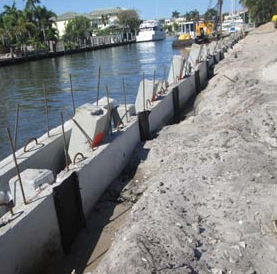With over 20 years of combined expertise Furlong Seawalls LLC can assist you with your seawall. As a Florida Marine Contractor we know how to evaluate, estimate, plan, design, and build a seawall to enhance and protect your waterfront property and it’s value. Read below to learn more about matzerials used in building a seawall.
Building a Seawall
Designing and Building a Seawall:
The following design considerations need to be addressed to be able to properly assess the condition of the seawall to determine a proper course of action for a new seawall assembly:
These additional design considerations need to be addressed
If a seawall is determined by the marine contractor to be damaged or deteriorated, the original design may not have accounted for the above-listed design considerations. Original or “as-built” seawall plans can provide a wealth of information including the age of the structure and many of the design elements listed in the above paragraphs. The deteriorated condition of a wall may also be an indication that the wall is in need of maintenance or that the sea wall construction has fulfilled it’s service life.
Seawall Structural Evaluation Info:
The American Society of Civil Engineers (ASCE) Underwater Investigations Standard Practice Manual was released in 2001 for marine contractors and and provides guidance for the evaluation of walls. Procedures are also applicable for above-water structures. Most bulkheads are along the waterfront, and should be evaluated above and below the water, whereas seawalls typically are not exposed to water on a regular basis.
The following topics are covered related to structural integrity of seawall evaluation for marine construction:
- Qualifications of Inspection Personnel
- Types and methods of inspections
- Typical forms of deterioration
- Condition Rating
- Frequency of Inspection
A comprehensive marine construction report is essential to document a proper seawall or bulkhead evaluation. All of the above items should be included along with photographs and sketches of the observed configuration with notes regarding deterioration. Comparison of previous reports provides an indication of the rate of deterioration.
Repair recommendations, along with marine construction cost estimates, should be included to provide the property owner with sound engineering advice so they can plan for maintenance or repairs as necessary. The report should be sealed by a registered professional engineer experienced in the evaluation of in-service marine structures.
Seawall & Construction Materials Info:
Seawalls are constructed of similar materials. The material of the wall must be properly identified prior to assessing the condition. The following table presents common seawall construction materials with comments regarding availability, construction issues, and general performance in the marine environment:
Vinyl: Relatively new economical product with service life of 50+ years. Available in different colors. Limited strength characteristics for wall heights. Difficult to install in hard substrates.
Concrete: Pile, panel and sheet piling configurations common in South West Florida. A common seawall material in due to the locally available aggregate; provides service life of 30+ years if correct mix and proper marine structural design implemented.
Steel: Steel sheet piling is commonly used for seawalls. Material provides excellent strength characteristics for high wall exposure applications. Provides interlocking seal, and generally easy to install, even in harder substrate. Must be properly coated and maintained for long service life of 25+ years.
Aluminum: Aluminum sheet piling provides good corrosion resistance, but lighter sections allow for minimal exposed wall height. Recognize corrosion potential of dissimilar metal hardware, do not use in waters with low Ph or back-fill with clay-mucky soils. Difficult to install in hard substrates. Not often used in South West Florida, but occasionally seen on inland waterways.
Timber: Timber pile/wale/sheet system is a common structural configuration. Generally economical material, but limited strength characteristics for high wall heights. Preservative treatment is essential for marine organisms. Difficult to install in hard substrates. Relatively new economical product with service life of 50+ years. Available in different colors. Limited strength characteristics for wall heights.

